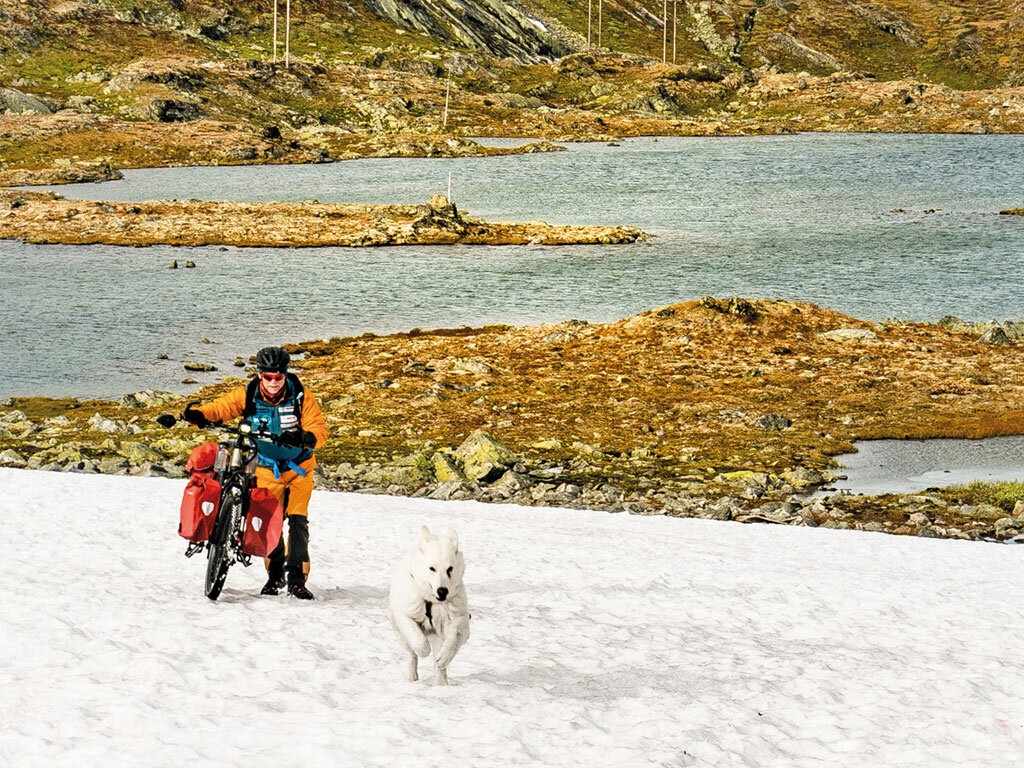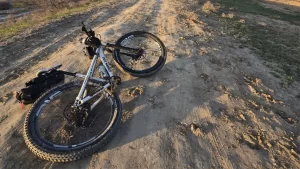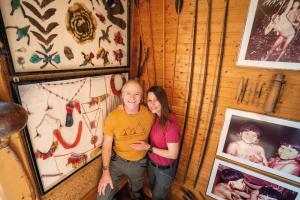I spoke to Denis Katzer, adventurer extraordinaire, about his long-distance experiences with the Riese & Müller Superdelite e-bike during.
After your epic walk through the Australian desert with camels, Tanja and yourself turned to cycling as a way to further enhance your Big Journey. What encouraged you to consider e-bikes?
We need to roll back a few years so that you can have better idea of what we had set out to achieve: we started riding for Riese & Müller in 2005, and first embarked on a journey with conventional, muscle-powered bicycles, from our home just outside Nuremburg, Germany, to Mongolia. (You have to remember that, at the time, e-bikes had yet to evolve into anything more than a form of recreational transportation for short commutes, a bit of shopping, or brief excursions close to home.) This was a gargantuan trip, and the toll it took upon us would contribute significantly to our decision-making for the future.
Firstly, Tanja was signalling that she wanted to give up cycling altogether. Secondly, after several years in the saddle, we arrived in Ulaanbaatar and I was unable to walk down any stairs for three months. My knees were seriously inflamed.
I should point out that, even though our bikes were technically amongst the best in the world, they were extremely heavily laden. After all, we had prepared ourselves to cope with all seasons and temperatures as low a -20°C. This meant we had to carry full winter clothing and a suitable tent. Not to mention the camera and video equipment, spare parts, and our dog who weighs 35 kg.
It was impossible to ride up the mountain passes. We were forced to dismount and spent a lot of time pushing our bikes and trailer uphill. You can’t begin to imagine the physical effort it took, or the immense strain on our backs as a consequence of a bent posture, as we struggled to push onward and up.
We both knew we couldn’t keep doing this for much longer.
Ok, so you were at the end of your physical and mental resources. How far had you actually cycled, and in what amount of time?
Somewhere north of 25,000 km in the period between 2005 and 2015. Now, that may not sound like a lot if you break it down into kilometres per year, but you need to remember we were using the bikes as our mode of transport between expeditions, which were physically demanding challenges in their own right. In a bid to travel as sustainably as possible, we had sold our argument to Riese & Müller by explaining we would swap aeroplanes and other four-wheeled means of transport for bicycles in order to reach the starting points of our next adventures. This was a huge feat during the ten-year span.
You broached the idea of using e-bikes to Riese & Müller. How did they respond?
Our expeditions project was on the brink of failure, so I spoke to Heiko Müller and explained that e-bikes could be our saviour. This was in 2012. Heiko’s response was rather sobering: he was quite adamant when he said the electric motors and batteries at the time simply weren’t ready for the loads and long distances we had in mind.
I didn’t give up though. In 2014, I went back to Heiko and said we had a new tour planned and really wanted to give e-bikes a try. I must have been quite persuasive because he finally agreed. The next thing I knew, I was in the R&D department working together with the engineers to construct bikes for Tanja and myself exactly to our requirements. I can’t express how grateful I was for the opportunity. All of a sudden, I knew the bikes inside and out. At the same time, I could inject our own experience into the development to resolve issues we had previously encountered on our journeys.

Your experience, and the kilometres you have accumulated, have flowed into the development of Riese & Müller e-bikes. This knowledge has in turn assisted their component manufacturers as well. Please tell me about your current bikes, the configuration, and some of the factors that influenced your choices.
Today, Tanja and I ride identically configured Riese & Müller Superdelite e-bikes which have an aluminium frame and full suspension. The electric motor is a Bosch New Performance CX 25 kmh Gen4 12V/1Ah, powered by two 500 W batteries. The most recent version of the same model has one 500 W and one 625 W battery.
BATTERIES
We were the first to cross the Gobi desert on e-bikes. As you can probably guess, there aren’t many places to recharge the batteries. At the time, the batteries were 400 W each, and we thought we would be ok if we took along three extras each. A gross miscalculation on our part, which was nearly our demise. Riding in the desert meant taking along considerably more water than usual…more weight, more drain on the batteries. We barely ever saw any vehicles on the road we were travelling, and the ones we did see all drove past when we tried to flag them down. We quickly learned that six batteries per person would give us a realistic radius of around 150 km, which would vastly improve our chances of finding somewhere to recharge.
BRAKES
The brakes are from Magura but without ABS. This is our choice because we want to minimise the amount technology that could go wrong. Imagine the bike falls over, the sensor become damaged, and the brakes become redundant. Rather no ABS in favour of a durable braking system.
We had a close call in China on a downhill stretch in the mountains. The bike, trailer and load (including the dog) all add up to around 150 kg, without the rider. That’s a lot of gear and weight. The original brakes weren’t up to the job and ran so hot that the brake fluid turned to gas, rendering the brakes completely useless just as we were heading for a hairpin bend and a vertical drop over the precipice of more than several hundred metres. Our saving grace was a wall in a petrol station which brought us to an, albeit, abrupt halt, but a safe one.
We discussed our problem with Magura who explained that we were carrying too much weight for the standard brake disks. These were then exchanged for larger, 203 mm diameter versions. In extreme situations, we even resorted to cooling the system with water which, admittedly, isn’t the best option for the materials.
LIGHTS
The headlamp on the Superdelite is a Supernova M99 Pro which provides a broad beam of light for safe navigation at night, even under heavy braking when the forks compress. The Supernova M99 tail light is also exceptionally bright and has a brake-light function for improved safety.
Despite the efficiency of the Supernova, I have chosen to use a Lupine SLF at the front.
COCKPIT
On the business side of things, we have stuck with the Bosch Intuvia cockpit which comes as standard and offers some highlights including a gear-change prompt and the ability to charge a smartphone (for example, when it is used for navigation). Six different riding modi are available depending upon the amount of assistance you require: Eco, Tour, Sport, eMTB, and Turbo. The sixth option allows you to switch off the assistance completely. As you can anticipate, the higher the assistance you call upon from the battery and motor, the more limited the distance you can travel.
If you require more flexibility and functionality, the Intuvia display can be replaced by one of the optional alternatives: Kiox, SmartphoneHub, or the Nyon.
CHAIN OR BELT
The Superdelite can be equipped with a belt drive to improve serviceability in urban use. The benefits include minimised wear, they are easy to fit and do not require lubrication. However, for longevity and durability under off-road conditions, the standard chain configuration is probably the better choice. Tanja and I have used KMC chains on most of our journeys, and they have proven exceptionally reliable, achieving an average of 10,000 km before they have to be replaced along with the front and rear sprockets.
SUSPENSION
The Superdelite is a “fully” with a highly effective front and rear suspension designed to cope with almost anything put in its path. We have upgraded the front forks to the optional Fox Float 34 Performance 100 Boost with additional compression to cope with the load our bikes are subjected to every day.
SADDLE
In my eyes, the Brookes B17 Special Titanium can’t be beaten. This leather saddle has been made for over 100 years and has hardly changed at all over that time. In fact, the few changes between the different models are either aesthetic or weight related.
A leather saddle needs around 1,000 km before it is finally moulded to your bum. Trust me, that’s important. It may well be that those first thousand are the toughest, but thereafter, you will feel really comfortable. We haven’t had much success with gel saddles—if they don’t fit from the outset, they never will.
The Brookes B17 is a bit like a sofa. I can sit on it for eight or ten hours a day and feel really comfortable. Cycling 150 or 200 km in a day wouldn’t be possible on another saddle…well, it might be, but you certainly won’t want to get back on your bike the next day [laughs].
HANDLEBARS
This is just as important as the saddle. When riding long distances, you need to be able to use different grips—otherwise your fingers and hands can quickly go numb.
The basic handlebars are the factory Humpert Ergo XXL in black, combined with a Humpert Ergotec Barracuda Evo 20° stem which sits in the Acros Block-Lock race. These harmonise with the bike perfectly.
The next step for us is being able to move around the handlebars for diversification of grip…and we have added Ergon GP30-L horns. These provide the control and freedom of movement we need.
TYRES
Despite our unconventional payload and the extreme distances we cover in all terrain, Schwalbe Marathon Plus MTBs are the best we have come across. I know that Riese & Müller work very closely with Schwalbe to develop tyres that are safe in all weathers and durable.
GEARS
We chose the Rohloff Speedhub with 14 gears. Most recently, we were in Norway and crossed Europe’s largest glacier. As usual, fully kitted and with trailers. In the past, the lowest gear was simply too low—cycling was a frenzy of feet and legs spinning blindingly fast. Now, the ratios have been reconfigured and they are just about as ideal as they can get.
When you’re riding through mountainous regions, you need to change gear continuously. The Speedhub is quick and accurate even under extreme situations.
There is an electronic gear changer, but we prefer to stick with a manual shift. Mechanically, I have never had any issues with the Rohloff hub, and they are absolutely service friendly—all they need is the occasional oil change.
LUGGAGE
At the front, we have the non-factory faiv (ArtMann) lowrider equipped with Ortlieb bags. We restrict the payload to 10 kg per side for better steering.
Instead of a normal handlebar bag, Riese & Müller have come up with a far better solution. Until now, having a loaded bag on the bars meant you had to take into account and control the extra ballast as well. Today, the rack, which accommodates the pouch, is attached to the bike’s frame leaving the handlebars unburdened. This adds a lot of comfort for the rider without reducing the amount we can stow.
At the rear, we use the factory rack which is very strong and can carry considerable weight. This is equipped with one bag on each side and one on top—all from Ortlieb.
TRAILER
I won’t go into too much detail about the trailer now because, even though we have always used them, they seem to be in a state of eternal evolution. I’m quite sure we are pretty much there, but I’d like to discuss the trailer, the braking system, and the coupling separately when I am completely satisfied with the configuration. I’m not sure how many people need to carry so much luggage, but if they do, then I want to be certain that what I am saying is correct.
The last really big tour took you through 17,000 km and a total elevation of 80,000 metres. I believe it is fair to say you have gathered more experience regarding your e-bikes than most people ever will. Is there any particular weakness that you have identified?
The only real issue we have encountered was the result of not having configured the trailer and hitch adequately. It is vitally important to spread the load in the trailer evenly, especially with e-bikes, because of the shear force that can develop. It took a while before we found the right balance and now we only tow trailers equipped with an overrun brake and heavy duty hitch.
But if we look at the setbacks over the distance we covered between 2015 and 2017, then the problems we incurred weren’t factory deficits, they were the result of us pushing the bikes to the limit every day and under conditions seldom encountered. As I said earlier, the rig has a total weight of around 150 kg without the rider. The frame, bearings, brakes, drive train, electric motor, batteries, and everything else have all been subjected to what some might term abuse.
Along the way, we had our moments, such as the failing brakes. But, after consulting the manufacturer, we were advised to upgrade to a larger diameter and the problem was solved. Let’s face it, the problem wasn’t the components the factory had chosen (and they really do only work with premium suppliers), the problem was us, the dog, and the equipment we had to carry. Kinetic energy…once set in motion, it takes quite something to stop it again. Problem identified, solution presented.
In all the time we have been travelling, we have, of course, run into small instances of wear and tear. Nothing I couldn’t solve at the time and nothing major. Not once did we have any problems with bearings or bushes. What I have observed though, is how Riese & Müller engineers translate our experience into improved mass-production e-bikes.
Don’t misinterpret me, but similarly to the influence the Formula 1 has on the car industry, that is what we have done for Riese & Müller. We push the boundaries and limitations day in, day out.
We are very fortunate to have found such an open-minded and innovative company, capable of providing the durable e-bikes we need to transport us and our equipment between the different expeditions.
Thank you for your time and sharing your impressions on the Riese & Müller Superdelite e-bike.
From € 7,149 | r-m.de







